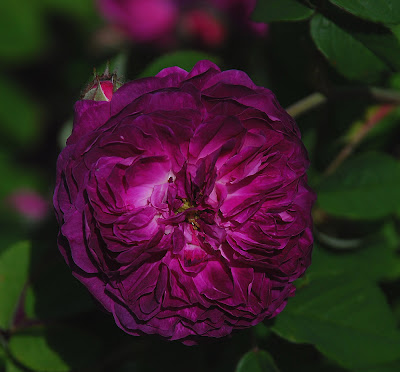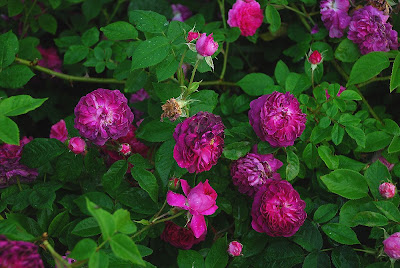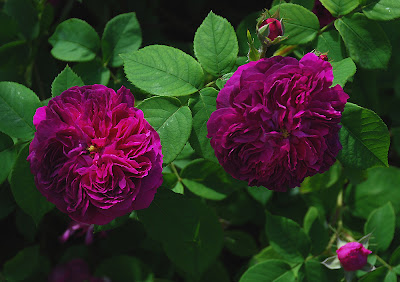It has enchanted me at first sight, but for many years I have not even dared to think about this rose, because I thought it must be a very sensitive royal princess. However, quite on the contrary, in the reality it is one of the most robust and frost hardy roses.

It has an unbelievable color. You would think that these photos are manipulated, but no. It is really something so purple-violet-grey-beet-aubergine. In the life it is unspeakably beautiful. However, it is very difficult to take good pictures on it. None of these photos are perfect, nevertheless they give some impression of it.

In any case, they show well that complex subtlety that is completely missing from twentieth-century roses.

It is undoubtedly far from the idea of “neat and tidy”. This is its most attractive feature.

 class:
class: Gallica rose, before 1847 (
Louis-Joseph-Ghislain Parmentier)
height: 90 - 185 cm - At us it is around 120 cm.
width: 60- 90 cm - At us around 120 cm.
American hardiness zone: Z4b (down to -32 ºC)
bloom: once





































 Even its shrub is beautiful.
Even its shrub is beautiful. class: Gallica rose (Louis-Joseph-Ghislain Parmentier before 1842)
class: Gallica rose (Louis-Joseph-Ghislain Parmentier before 1842) Rudolf Geschwind was one of the most famous rose breeders of the 19th century. He was the first to produce frost-hardy roses in Europe.
Rudolf Geschwind was one of the most famous rose breeders of the 19th century. He was the first to produce frost-hardy roses in Europe. His name is associated with such world famous roses like for example Geschwind's Nordlandrose or Geschwind's Schönste, Gipsy Boy or Grüss an Teplitz.
His name is associated with such world famous roses like for example Geschwind's Nordlandrose or Geschwind's Schönste, Gipsy Boy or Grüss an Teplitz. When I have seen his roses the first time in Praskac, I have thought: well, that’s famous old German rose breeding!
When I have seen his roses the first time in Praskac, I have thought: well, that’s famous old German rose breeding! A little later, when I have seen a list of his roses with names like Corporal Johann Nagy or Julius Fabianics de Misefa, then it became a little bit suspicious: perhaps he has some Hungarian relation?
A little later, when I have seen a list of his roses with names like Corporal Johann Nagy or Julius Fabianics de Misefa, then it became a little bit suspicious: perhaps he has some Hungarian relation? In fact, he had. His nursery was in Hungary, on Korpona. Help Me Find registers him as a Hungarian rose breeder.
In fact, he had. His nursery was in Hungary, on Korpona. Help Me Find registers him as a Hungarian rose breeder. There was a time when we lived in the middle of Europe.
There was a time when we lived in the middle of Europe. class: wild rose hybrid (Rudolf Geschwind 1886)
class: wild rose hybrid (Rudolf Geschwind 1886) It has an unbelievable color. You would think that these photos are manipulated, but no. It is really something so purple-violet-grey-beet-aubergine. In the life it is unspeakably beautiful. However, it is very difficult to take good pictures on it. None of these photos are perfect, nevertheless they give some impression of it.
It has an unbelievable color. You would think that these photos are manipulated, but no. It is really something so purple-violet-grey-beet-aubergine. In the life it is unspeakably beautiful. However, it is very difficult to take good pictures on it. None of these photos are perfect, nevertheless they give some impression of it. In any case, they show well that complex subtlety that is completely missing from twentieth-century roses.
In any case, they show well that complex subtlety that is completely missing from twentieth-century roses. It is undoubtedly far from the idea of “neat and tidy”. This is its most attractive feature.
It is undoubtedly far from the idea of “neat and tidy”. This is its most attractive feature.
 class: Gallica rose, before 1847 (Louis-Joseph-Ghislain Parmentier)
class: Gallica rose, before 1847 (Louis-Joseph-Ghislain Parmentier)